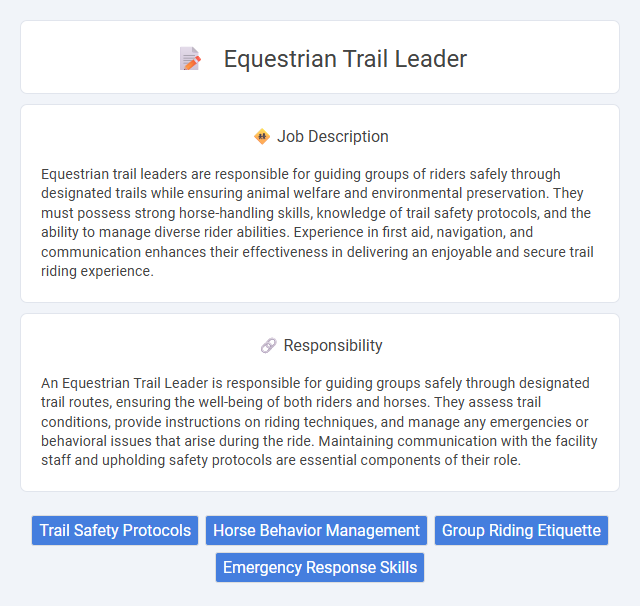
Equestrian trail leaders are responsible for guiding groups of riders safely through designated trails while ensuring animal welfare and environmental preservation. They must possess strong horse-handling skills, knowledge of trail safety protocols, and the ability to manage diverse rider abilities. Experience in first aid, navigation, and communication enhances their effectiveness in delivering an enjoyable and secure trail riding experience.
Individuals with strong physical fitness and a passion for outdoor activities will likely find the role of an equestrian trail leader suitable due to the demanding nature of guiding horses and riders through varied terrain. Those comfortable with animal handling and possessing good communication skills are probably better equipped to ensure safety and a positive experience for all participants. People with limited stamina, fear of animals, or poor leadership abilities may struggle with the physical and interpersonal challenges inherent in this job.
Qualification
Equestrian trail leaders must have strong horsemanship skills, including riding proficiency and horse behavior understanding, often requiring certification from recognized equestrian organizations. Candidates typically need experience in trail riding management, safety protocols, and first aid to ensure rider and equine well-being. Knowledge of local trails, environmental conservation, and the ability to guide diverse groups effectively are critical qualifications for success in this role.
Responsibility
An Equestrian Trail Leader is responsible for guiding groups safely through designated trail routes, ensuring the well-being of both riders and horses. They assess trail conditions, provide instructions on riding techniques, and manage any emergencies or behavioral issues that arise during the ride. Maintaining communication with the facility staff and upholding safety protocols are essential components of their role.
Benefit
Equestrian trail leaders likely offer a range of benefits, including the opportunity to work outdoors in scenic environments while engaging with horses. This role probably enhances leadership skills and provides physical exercise, contributing to overall well-being. It may also foster a sense of community and connection with nature, appealing to those interested in both animals and outdoor activities.
Challenge
Equestrian trail leader positions likely involve significant physical and mental challenges, including managing diverse trail conditions and ensuring rider safety. Navigating unpredictable weather and animal behavior often requires quick decision-making and strong leadership skills. The role probably demands endurance and adaptability to maintain a positive, secure experience for all participants.
Career Advancement
Equestrian trail leaders gain valuable experience in horse handling, trail safety, and client interaction, laying a strong foundation for career advancement within the equestrian industry. Opportunities for growth include roles such as stable manager, riding instructor, or equine program coordinator, where leadership and expertise in horse care are essential. Specialized certifications and continuous professional development enhance prospects for higher-level positions and increased responsibilities.
Key Terms
Trail Safety Protocols
Equestrian trail leaders enforce strict trail safety protocols to ensure the protection of both riders and horses during excursions. They conduct thorough pre-ride safety briefings, inspect tack and equipment for secure fit, and monitor environmental conditions to avoid hazards. Their expertise in identifying trail risks and managing group dynamics minimizes accidents and promotes a safe riding experience.
Horse Behavior Management
Equestrian trail leaders must possess expert knowledge in horse behavior management to ensure rider safety and horse well-being during rides. Understanding equine body language, recognizing signs of stress or agitation, and implementing calming techniques are critical for managing horses on diverse trail terrains. Effective communication with horses reduces the risk of accidents and enhances the overall trail experience.
Group Riding Etiquette
Equestrian trail leaders ensure safe and enjoyable group rides by enforcing strict group riding etiquette, such as maintaining proper spacing between horses to prevent accidents and respecting trail rules to protect the environment. They guide riders in clear communication and position management, promoting a harmonious and controlled riding experience. Expertise in horse behavior and rider skill levels is essential to anticipate and mitigate risks during the trail ride.
Emergency Response Skills
Equestrian trail leaders must possess strong emergency response skills, including first aid certification and the ability to manage injuries or medical issues for riders and horses on remote trails. Proficiency in assessing trail hazards, coordinating rescue efforts, and communicating effectively via radio or satellite devices is essential for ensuring group safety. These skills are critical for swift, calm decision-making in emergencies, minimizing risks and enhancing overall trail experience security.
 kuljobs.com
kuljobs.com